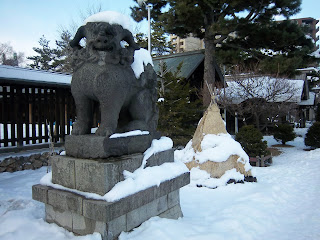
6 January 2011 – Intermittent blizzard in Sapporo
Winter weather on Hokkaido
Thick snow is blowing sideways, whereas a few minutes ago it seemed the sun would come out. I walked [about ½ hour] in from my university housing to my office at Hokkaido University during a blizzardy time, luckily not walking upwind. As I turned south, I could see the sun through the thin clouds. Then one long peal of thunder rolled across the sky, and the air around me thickened with flakes.
I suppose it is the island effect, with the Sea of Japan, Sea of Okhotsk, and north Pacific surrounding us. Our latitude is about 43° -- like southern New England, but with more moisture pouring off the seas and condensing into flakes even when the sun is shining. I wished for snow, I got it.
Fashion in winter on Hokkaido
Attention to fashion is the realm especially of young women here. In the summer in Tokyo I had seen the short skirts and kneesocks, cutesy, kitschy styles. What would winter style be like? Well, it’s still short skirts, or fur-lined shorts, plus hosiery or leggings and short to tall boots. Even today in the blizzard conditions I saw such an outfit. Once on an escalator I was behind a fur hat, jacket, very short fur skirt, leggings and fur boots. I wished I had my camera out.
Cute is part of Japanese fashion, especially for young women, but … when I went with Hondo-san to get a bank account, she urged me to order, rather than a plain bankbook, one with cutesy bears and cats and foxes on it. I a 60-year-old woman….
Shopping—lost in translation
There is a large supermarket near my flat, including a very large cosmetics section, a 100-yen shop, and a grocery store that goes on forever. Too bad I can’t read most of what’s on the shelves… is it shampoo? Rinse? Dishwashing liquid? Hand soap? Skin conditioner? I thought the U.S. had too many choices already, but here, cosmetics and soaps are a major focus.
In the grocery
I came home with: bananas, mandarins, apples, rice crackers [clear packaging], dried-bean snack, tea bags, grated cheese, parmesan, eggs, some dark sauce in a bottle that might be soy sauce or else one of a thousand other possibilities, green-tea mochi, a few bakery items [raisin/nut bread, bread with corn on it, bread with broccoli, bacon and white sauce on it], one can of Kirin stout, one small bottle of champagne [to toast Beth’s Ph.D. completion], no sushi, partly because I was trying to avoid much packaging. I am an adventurous eater, in general, but I need a guide – what possessed me to visit a country where I can’t read the characters, let alone understand the spoken language.
Why did I come here?
Japan is of course an epicenter of tsunami and paleotsunami and paleoseismology studies. As we do in Cascadia, they have an active subduction zone and active volcanoes and of course a history [and pre-history] of big earthquakes and tsunamis. Tsunami is, of course, a Japanese word meaning “harbor wave” – Japanese does not have a plural form, but I go ahead and say “tsunamis” in my anglicized/scientific version of the word.
I have colleagues here at Hokkaido University in seismology, tsunami studies [should we call ourselves tsunami-ologists?], sedimentology, paleoseismology and volcanology. And I have many colleagues at other institutions in Japan. I’ll introduce more of these colleagues later.
For years, I resisted coming to Japan. Not just the language intimidated me [it was hard enough for me to learn basic Russian, now my brain has less flexibility than ever]. I also had an early experience with the clash of cultures between me – brash young American woman scientist – and a much more authority-driven Japanese tsunami-survey team in Nicaragua in 1992. I had virtually no cultural sensitivity, and… I didn’t really want to.
Now I am old[er] and distinguished in my field, and even a bit more culturally sensitive, so I hope to have a rewarding visit. My shorter visits already on several prior occasions have been happy ones. I have had wonderful hosts, and everything about Japan is fascinating, and just about everything seems different, except the volcanoes and earthquakes and tsunamis. As my freshman geology teacher said, “If you learn geology, you can travel anywhere in the world and not be a stranger.”

Very good, we look forward to hearing about your travels and research!
ReplyDeleteJ. Garver